AOAC2002抗性淀粉(中文翻译)
- 格式:doc
- 大小:35.00 KB
- 文档页数:3
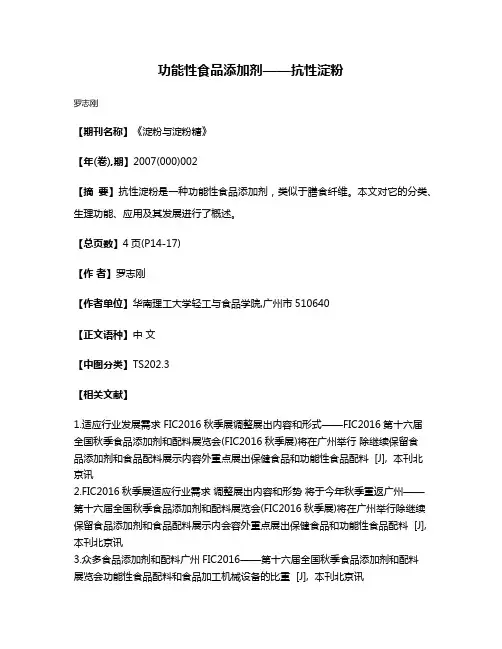
功能性食品添加剂——抗性淀粉
罗志刚
【期刊名称】《淀粉与淀粉糖》
【年(卷),期】2007(000)002
【摘要】抗性淀粉是一种功能性食品添加剂,类似于膳食纤维。
本文对它的分类、生理功能、应用及其发展进行了概述。
【总页数】4页(P14-17)
【作者】罗志刚
【作者单位】华南理工大学轻工与食品学院,广州市510640
【正文语种】中文
【中图分类】TS202.3
【相关文献】
1.适应行业发展需求 FIC2016秋季展调整展出内容和形式——FIC2016第十六届全国秋季食品添加剂和配料展览会(FIC2016秋季展)将在广州举行除继续保留食
品添加剂和食品配料展示内容外重点展出保健食品和功能性食品配料 [J], 本刊北京讯
2.FIC2016秋季展适应行业需求调整展出内容和形势将于今年秋季重返广州——第十六届全国秋季食品添加剂和配料展览会(FIC2016秋季展)将在广州举行除继续保留食品添加剂和食品配料展示内会容外重点展出保健食品和功能性食品配料 [J], 本刊北京讯
3.众多食品添加剂和配料广州FIC2016——第十六届全国秋季食品添加剂和配料
展览会功能性食品配料和食品加工机械设备的比重 [J], 本刊北京讯
4.新型健康食品添加剂——抗性淀粉 [J],
5.适应行业发展需求 FIC2016秋季展调整展出内容和形式——FIC2016第十六届全国秋季食品添加剂和配料展览会(FIC2016秋季展)将在广州举行除继续保留食品添加剂和食品配料展示内容外重点展出保健食品和功能性食品配料 [J], 本刊北京讯
因版权原因,仅展示原文概要,查看原文内容请购买。
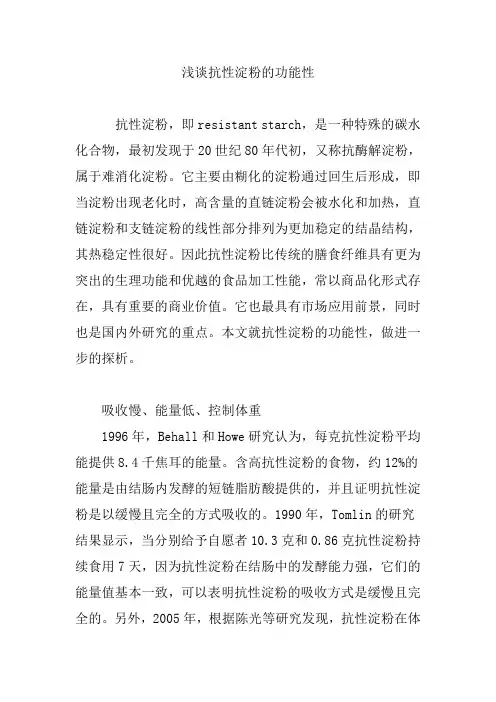
浅谈抗性淀粉的功能性抗性淀粉,即resistant starch,是一种特殊的碳水化合物,最初发现于20世纪80年代初,又称抗酶解淀粉,属于难消化淀粉。
它主要由糊化的淀粉通过回生后形成,即当淀粉出现老化时,高含量的直链淀粉会被水化和加热,直链淀粉和支链淀粉的线性部分排列为更加稳定的结晶结构,其热稳定性很好。
因此抗性淀粉比传统的膳食纤维具有更为突出的生理功能和优越的食品加工性能,常以商品化形式存在,具有重要的商业价值。
它也最具有市场应用前景,同时也是国内外研究的重点。
本文就抗性淀粉的功能性,做进一步的探析。
吸收慢、能量低、控制体重1996年,Behall和Howe研究认为,每克抗性淀粉平均能提供8.4千焦耳的能量。
含高抗性淀粉的食物,约12%的能量是由结肠内发酵的短链脂肪酸提供的,并且证明抗性淀粉是以缓慢且完全的方式吸收的。
1990年,Tomlin的研究结果显示,当分别给予自愿者10.3克和0.86克抗性淀粉持续食用7天,因为抗性淀粉在结肠中的发酵能力强,它们的能量值基本一致,可以表明抗性淀粉的吸收方式是缓慢且完全的。
另外,2005年,根据陈光等研究发现,抗性淀粉在体内所产生的热量很低,不到淀粉的十分之一,因此认为抗性淀粉在体内是低能量甚至不产生能量的,可以做为减肥食品的原料。
降低血糖抗性淀粉进入体内后,在胃中较难消化,且吸收和进入血液的时间较长,具有减少体内血糖的作用。
白建江等指出,高抗性淀粉有较明显的降低Ⅱ型糖尿病大鼠血糖的作用和糖耐量的提高。
王博等也指出,通过抗性淀粉饮食治疗后的患者单日平均血糖,空腹,早、中、晚餐后的平均血糖均明显降低,最高血糖水平降低,而最低血糖水平与之前没有明显变化,从而降低了最高与最低的血糖差;另外他还指出将抗性淀粉作为低热量、高膳食纤维的功能食品成分,是饮食治疗糖尿病患者的良好选择之一。
降低血脂国内外在研究抗性淀粉的降血脂功能上均有较大发现。
白建江等研究发现,抗性淀粉有明显改善2型糖尿病大鼠脂代谢紊乱的作用,有较明显的降脂作用。
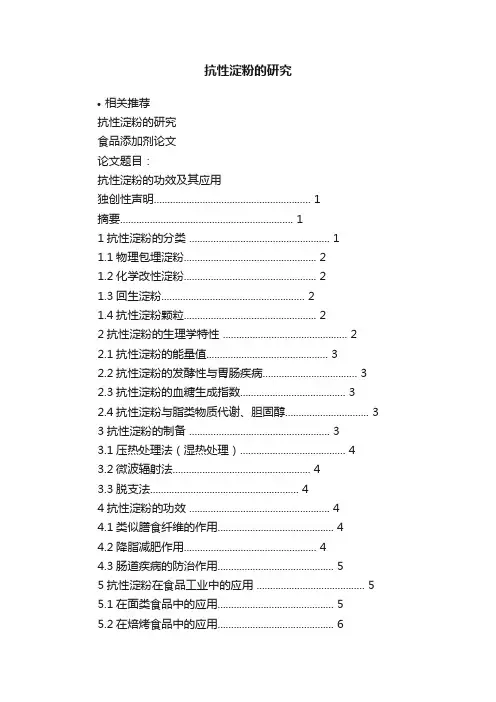
抗性淀粉的研究•相关推荐抗性淀粉的研究食品添加剂论文论文题目:抗性淀粉的功效及其应用独创性声明 (1)摘要 (1)1抗性淀粉的分类 (1)1.1物理包埋淀粉 (2)1.2化学改性淀粉 (2)1.3回生淀粉 (2)1.4抗性淀粉颗粒 (2)2抗性淀粉的生理学特性 (2)2.1抗性淀粉的能量值 (3)2.2抗性淀粉的发酵性与胃肠疾病 (3)2.3抗性淀粉的血糖生成指数 (3)2.4抗性淀粉与脂类物质代谢、胆固醇 (3)3抗性淀粉的制备 (3)3.1压热处理法(湿热处理) (4)3.2微波辐射法 (4)3.3脱支法 (4)4抗性淀粉的功效 (4)4.1类似膳食纤维的作用 (4)4.2降脂减肥作用 (4)4.3肠道疾病的防治作用 (5)5抗性淀粉在食品工业中的应用 (5)5.1在面类食品中的应用 (5)5.2在焙烤食品中的应用 (6)5.3在饮料及发酵制品中的应用 (6)5.4在保健食品中的应用 (6)6结束语 (6)参考文献............................................................ 7 致谢............................................... 错误!未定义书签。
独创性声明抗性淀粉的功效及其应用摘要:近年来,随着人们对于健康要求的更新,出现了一种比膳食纤维更对人类健康具有广泛意义的淀粉,便是抗性淀粉。
抗性淀粉是近年来兴起的一个概念,1992年,世界粮农组织根据专家建议,将其定义为“健康者小肠中不吸收的淀粉及其降解产物”。
本文对抗性淀粉的功能特性、分类及其制备进行了综述,介绍了抗性淀粉作为一种新型的食品添加剂,在食品工业上的应用及其特有的生理功能在促进人类健康中的作用。
关键字:抗性淀粉生理功能食品添加剂应用前言抗性淀粉(RS)是近年来发展起来的新概念。
最早,英国的生理学家将一部分在人体肠胃中不被淀粉酶消化的淀粉定义为抗性淀粉。
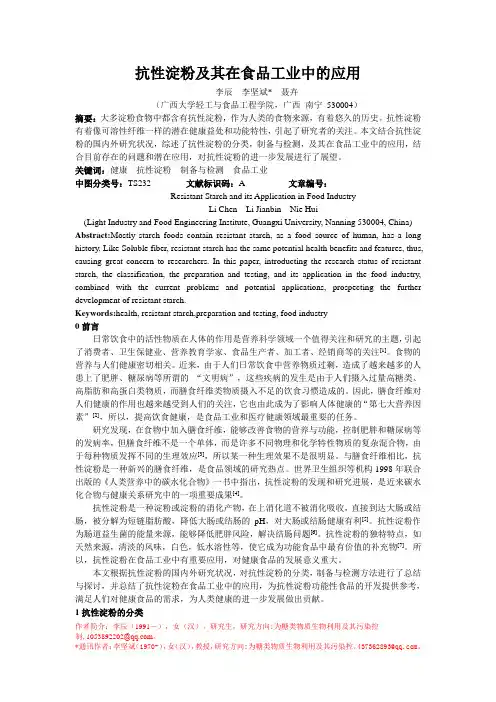
抗性淀粉及其在食品工业中的应用李辰李坚斌* 聂卉(广西大学轻工与食品工程学院,广西南宁530004)摘要:大多淀粉食物中都含有抗性淀粉,作为人类的食物来源,有着悠久的历史。
抗性淀粉有着像可溶性纤维一样的潜在健康益处和功能特性,引起了研究者的关注。
本文结合抗性淀粉的国内外研究状况,综述了抗性淀粉的分类,制备与检测,及其在食品工业中的应用,结合目前存在的问题和潜在应用,对抗性淀粉的进一步发展进行了展望。
关键词:健康抗性淀粉制备与检测食品工业中图分类号:TS232 文献标识码:A 文章编号:Resistant Starch and its Application in Food IndustryLi Chen Li Jianbin Nie Hui(Light Industry and Food Engineering Institute, Guangxi University, Nanning 530004, China) Abstract:Mostly starch foods contain resistant starch, as a food source of human, has a long history. Like Soluble fiber, resistant starch has the same potential health benefits and features, thus, causing great concern to researchers. In this paper, introducting the research status of resistant starch, the classification, the preparation and testing, and its application in the food industry, combined with the current problems and potential applications, prospecting the further development of resistant starch.Keywords:health, resistant starch,preparation and testing, food industry0前言日常饮食中的活性物质在人体的作用是营养科学领域一个值得关注和研究的主题,引起了消费者、卫生保健业、营养教育学家、食品生产者、加工者、经销商等的关注[1]。

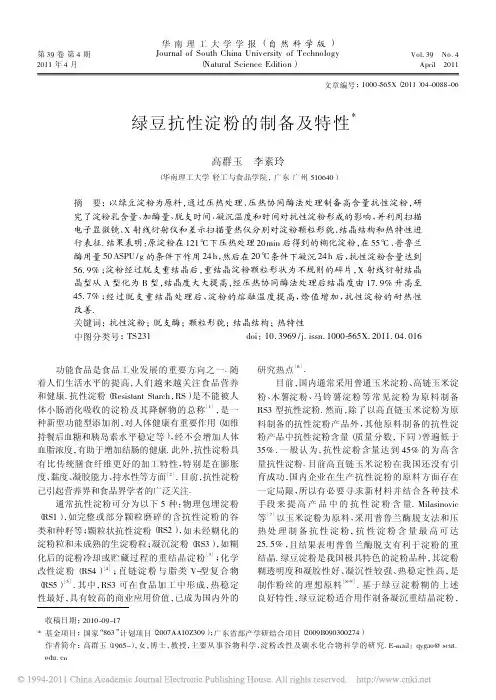
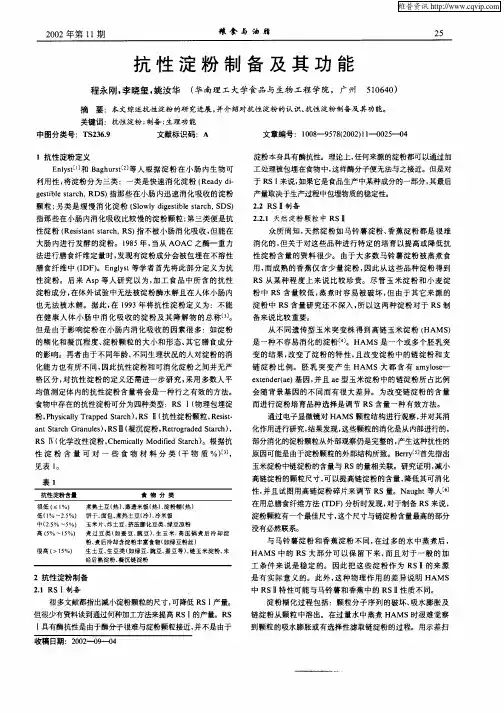
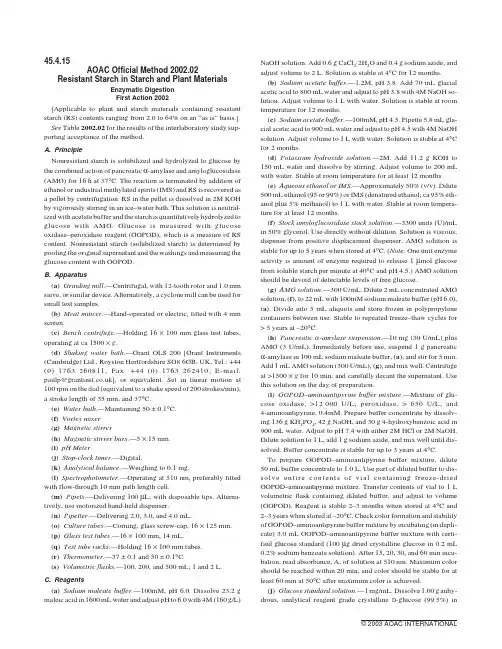
45.4.15AOAC Official Method2002.02Resistant Starch in Starch and Plant MaterialsEnzymatic DigestionFirst Action2002[Applicable to plant and starch materials containing resistant starch(RS)contents ranging from2.0to64%on an“as is”basis.] See Table2002.02for the results of the interlaboratory study sup-porting acceptance of the method.A.PrincipleNonresistant starch is solubilized and hydrolyzed to glucose by the combined action of pancreaticα-amylase and amyloglucosidase (AMG)for16h at37°C.The reaction is terminated by addition of ethanol or industrial methylated spirits(IMS)and RS is recovered as a pellet by centrifugation.RS in the pellet is dissolved in2M KOH by vigorously stirring in an ice–water bath.This solution is neutral-ized with acetate buffer and the starch is quantitatively hydrolyzed to glucose with AMG.Glucose is measured with glucose oxidase–peroxidase reagent(GOPOD),which is a measure of RS content.Nonresistant starch(solubilized starch)is determined by pooling the original supernatant and the washings and measuring the glucose content with GOPOD.B.Apparatus(a)Grinding mill.—Centrifugal,with12-tooth rotor and1.0mm sieve,or similar device.Alternatively,a cyclone mill can be used for small test samples.(b)Meat mincer.—Hand-operated or electric,fitted with4mm screen.(c)Bench centrifuge.—Holding16×100mm glass test tubes, operating at ca1500×g.(d)Shaking water bath.—Grant OLS200[Grant Instruments (Cambridge)Ltd.,Royston Hertfordshire SG86GB,UK,Tel.:+44 (0)1763260811;Fax:+44(0)1763262410;E-mail: paulp@],or equivalent.Set in linear motion at 100rpm on the dial(equivalent to a shake speed of200strokes/min), a stroke length of35mm,and37°C.(e)Water bath.—Maintaining50±0.1°C.(f)Vortex mixer(g)Magnetic stirrer(h)Magnetic stirrer bars.—5×15mm.(i)pH Meter(j)Stop-clock timer.—Digital.(k)Analytical balance.—Weighing to0.1mg.(l)Spectrophotometer.—Operating at510nm,preferably fitted with flow-through10mm path length cell.(m)Pipets.—Delivering100µL;with disposable tips.Alterna-tively,use motorized hand-held dispenser.(n)Pipetter.—Delivering2.0,3.0,and4.0mL.(o)Culture tubes.—Corning,glass screw-cap,16×125mm. (p)Glass test tubes.—16×100mm,14mL.(q)Test tube racks.—Holding16×100mm tubes.(r)Thermometer.—37±0.1and50±0.1°C.(s)Volumetric flask s.—100,200,and500mL;1and2L.C.Reagents(a)Sodium maleate buffer.—100mM,pH6.0.Dissolve23.2g maleic acid in1600mL water and adjust pH to6.0with4M(160g/L)NaOH solution.Add0.6g CaCl2⋅2H2O and0.4g sodium azide,and adjust volume to2L.Solution is stable at4°C for12months. (b)Sodium acetate buffer.—1.2M,pH3.8.Add70mL glacial acetic acid to800mL water and adjust to pH3.8with4M NaOH so-lution.Adjust volume to1L with water.Solution is stable at room temperature for12months.(c)Sodium acetate buffer.—100mM,pH4.5.Pipette5.8mL gla-cial acetic acid to900mL water and adjust to pH4.5with4M NaOH solution.Adjust volume to1L with water.Solution is stable at4°C for2months.(d)Potassium hydroxide solution.—2M.Add11.2g KOH to 150mL water and dissolve by stirring.Adjust volume to200mL with water.Stable at room temperature for at least12months. (e)Aqueous ethanol or IMS.—Approximately50%(v/v).Dilute 500mL ethanol(95or99%)or IMS(denatured ethanol;ca95%eth-anol plus5%methanol)to1L with water.Stable at room tempera-ture for at least12months.(f)Stock amyloglucosidase stock solution.—3300units(U)/mL in50%e directly without dilution.Solution is viscous; dispense from positive displacement dispenser.AMG solution is stable for up to5years when stored at4°C.(Note:One unit enzyme activity is amount of enzyme required to release1µmol glucose from soluble starch per minute at40°C and pH4.5.)AMG solution should be devoid of detectable levels of free glucose.(g)AMG solution.—300U/mL.Dilute2mL concentrated AMG solution,(f),to22mL with100mM sodium maleate buffer(pH6.0), (a).Divide into5mL aliquots and store frozen in polypropylene containers between use.Stable to repeated freeze–thaw cycles for >5years at–20°C.(h)Pancreatic a-amylase suspension.—10mg(30U/mL)plus AMG(3U/mL).Immediately before use,suspend1g pancreatic α-amylase in100mL sodium maleate buffer,(a),and stir for5min. Add1mL AMG solution(300U/mL),(g),and mix well.Centrifuge at>1500×g for10min,and carefully decant the e this solution on the day of preparation.(i)GOPOD–aminoantipyrine buffer mixture.—Mixture of glu-cose oxidase,>12000U/L;peroxidase,>650U/L;and 4-aminoantipyrine,0.4mM.Prepare buffer concentrate by dissolv-ing136g KH2PO4,42g NaOH,and30g4-hydroxybenzoic acid in 900mL water.Adjust to pH7.4with either2M HCl or2M NaOH. Dilute solution to1L,add1g sodium azide,and mix well until dis-solved.Buffer concentrate is stable for up to3years at4°C.To prepare GOPOD–aminoantipyrine buffer mixture,dilute 50mL buffer concentrate e part of diluted buffer to dis-solve entire contents of vial containing freeze-dried GOPOD–aminoantipyrine mixture.Transfer contents of vial to1L volumetric flask containing diluted buffer,and adjust to volume (GOPOD).Reagent is stable2–3months when stored at4°C and 2–3years when stored at–20°C.Check color formation and stability of GOPOD–aminoantipyrine buffer mixture by incubating(in dupli-cate)3.0mL GOPOD–aminoantipyrine buffer mixture with certi-fied glucose standard(100µg dried crystalline glucose in0.2mL 0.2%sodium benzoate solution).After15,20,30,and60min incu-bation,read absorbance,A,of solution at510nm.Maximum color should be reached within20min,and color should be stable for at least60min at50°C after maximum color is achieved.(j)Glucose standard solution.—1mg/mL.Dissolve1.00g anhy-drous,analytical reagent grade crystalline D-glucose(99.5%)in900mL of0.2%benzoic acid solution in water.Adjust volume to1L in volumetric flask and store in well-sealed glass container.Stable at room temperature>5years.Items(f)and(h)–(j)are supplied in the Resistant Starch Assay Kit available from Megazyme International Ireland Ltd.(Bray Business Park,Bray,County Wicklow,Ireland),but preparations of reagents and buffers which meet these criteria may also be used.D.Preparation of Test SamplesGrind ca50g test sample of grain or lyophilized plant material in grinding mill,B(a),to pass1.0mm sieve.Transfer all material to wide-mouthed plastic jar and mix well by shaking and inversion. Grinding is not required with industrial starch preparations supplied as a fine powder.E.Measurement of Resistant Starch(a)Hydrolysis of nonresistant starch.—Accurately weigh100±5mg test portion directly into each screw-cap tube,B(o),and gently tap the tube to ensure that material falls to the bottom.Add4.0mL pancreaticα-amylase(10mg/mL)containing AMG(3U/mL), C(h),to each tube.Tightly cap the tubes,mix on a Vortex mixer,and attach them horizontally,under water,in a shaking water bath,B(d), aligned in the direction of motion.Incubate at37°C with continuous shaking(200strokes/min for16h).(Note:For linear motion,a set-ting of100on the water bath is equivalent to200strokes/min; 100forward and100reverse.)Remove tubes from water bath and remove excess water on tubes with paper towel.Remove tube caps and add4.0mL IMS(99%,v/v) or ethanol(95–99%).Mix tube contents vigorously on Vortex mixer.Centrifuge tubes at ca1500×g for10min(noncapped).Care-fully decant supernatants and resuspend pellets in2mL50%IMS, C(e),with vigorous mixing on Vortex mixer,B(f).Add additional6 mL50%IMS,C(e),mix tubes,and centrifuge again at1500×g for 10min.Repeat this suspension and centrifugation step once more. Carefully decant supernatants and invert tubes on absorbent paper to drain excess liquid.(b)Measurement of RS.—Add magnetic stirrer bar(5×15mm) and2mL2M KOH,C(d),to each tube and resuspend the pellets. Dissolve RS by stirring for ca20min in an ice–water bath over a magnetic stirrer(do not mix on a Vortex mixer as this may cause the starch to emulsify).In this step,ensure that tube contents are being vigorously stirred when KOH solution is added to avoid formation of a lump of starch material which would be difficult to dissolve. Add8mL1.2M sodium acetate buffer(pH3.8),C(b),to each tube with stirring on the magnetic stirrer.Immediately add0.1mL AMG (3300U/mL),C(f),mix well on magnetic stirrer,and then place tubes in a water bath at50°C.Incubate tubes for30min with inter-mittent mixing on a Vortex mixer.For test samples containing>10%RS,quantitatively transfer con-tents of tube to100mL volumetric flask using water wash bottle. Use external magnet to retain stirrer bar in the tube while washing the solution from the tube with a water wash bottle.Adjust to100mL with water.Centrifuge an aliquot of the solution at1500×g for 10min.For test samples containing<10%RS,directly centrifuge tubes at1500×g for10min without dilution.For such products,the final volume in the tube is10.3±0.05mL.Transfer0.1mL aliquots(in duplicate)of either diluted or undi-luted supernatants into glass test tubes(16×100mm),B(p),add 3.0mL GOPOD reagent,C(i),mix tube contents on Vortex mixer, and incubate at50°C for20min.Prepare reagent blank solutions by mixing0.1mL0.1M sodium acetate buffer(pH4.5),C(c),and 3.0mL GOPOD reagent.Prepare glucose standards(in quadrupli-cate)by mixing0.1mL glucose(1mg/mL),C(j),and3.0mL GOPOD reagent,C(i).Incubate at50°C for20min,cool,and set spectrophotometer to0with the reagent blank.Measure the absorbance of each solution at510nm against the reagent blank.Av-erage duplicate absorbance values.The GOPOD color response with glucose is linear over the absorbance range0.0–1.5absorbance units.F.CalculationsCalculate RS(%,“as is”basis)in test samples as follows: (1)For products containing>10%RS.—RS(g/100g sample)=∆A×F×(100/0.1)×(1/1000)×(100/W)×(162/180)=∆A×F/W×90(2)For products containing<10%RS.—Table2002.02.Interlaboratory study results for measurement of resistant starch by enzymatic digestion in starch samples and se-lected plant materialsSample Mean RS a,%No.of labs b,c s r s R RSD r,%RSD R,%r d R e HORRATHylon VII(HAMS)f46.2937(0) 1.91 3.87 4.128.37 5.3410.84 3.72 Green banana43.5636(1) 1.39 3.69 3.188.47 3.8810.34 3.74 Native potato starch63.3935(2) 2.66 3.77 4.20 5.947.4510.54 2.77 CrystaLean(retrograded HAMS)39.0434(3)0.77 2.00 1.97 5.13 2.15 5.61 2.23 ActiStar(RS)48.2836(1) 1.12 2.81 2.32 5.83 3.147.87 2.61 Kidney beans(canned) 4.6635(2)0.110.21 2.42 4.580.320.60 1.44 Corn flakes 2.2034(3)0.080.24 3.4310.90.210.67 3.08a Calculated on“as is”basis(“as is”for banana,kidney beans,and corn flakes means on a lyophilized basis).b,c b=Number of collaborating laboratories(number of outlier laboratories).d r=2.8×sr .e R=2.8×sR .f High amylose maize starch.RS(g/100g sample)=∆A×F×(10.3/0.1)×(1/1000)×(100/W)×(162/180)=∆A×F/W×9.27where∆A=averaged absorbance(reaction)read against the reagent blank;F=conversion factor from absorbance to micrograms[the absorbance obtained for100µg glucose in the GOPOD reaction is determined and F=100(micrograms of glucose divided by the GOPOD absorbance for this100µg glucose];100/0.1=volume ad-justment(0.1mL taken from100mL);1/1000=conversion from micrograms to milligrams;W=“as is”weight of test portion ana-lyzed;100/W=factor to present starch as a percentage of test portion weight;162/180=factor to convert from free glucose,as deter-mined,to anhydro-glucose as occurs in starch;10.3/0.1=volume adjustment(0.1mL taken from10.3mL)for test portion containing 0–10%RS where the incubation solution is not diluted and the final volume is10.3±0.05mL.Reference:J.AOAC Int.85,1103(2002).。
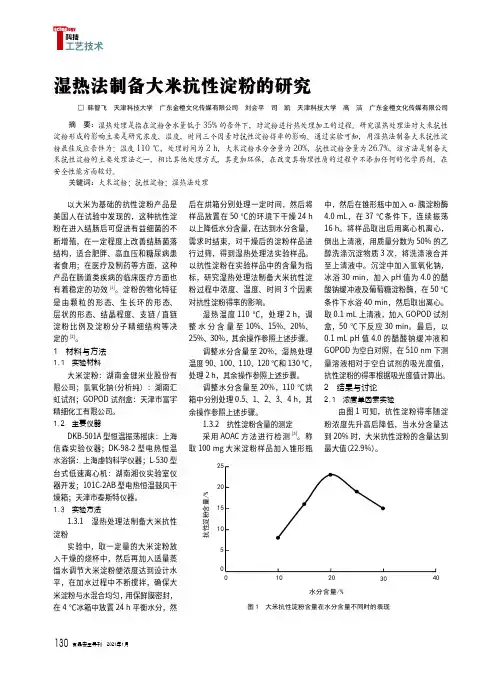
130 食品安全导刊 2021年1月Tlogy科技工艺技术以大米为基础的抗性淀粉产品是美国人在试验中发现的,这种抗性淀粉在进入结肠后可促进有益细菌的不断增殖,在一定程度上改善结肠菌落结构,适合肥胖、高血压和糖尿病患者食用;在医疗及制药等方面,这种产品在肠道类疾病的临床医疗方面也有着稳定的功效[1]。
淀粉的物化特征是由颗粒的形态、生长环的形态、层状的形态、结晶程度、支链/直链淀粉比例及淀粉分子精细结构等决定的[2]。
1 材料与方法1.1 实验材料大米淀粉:湖南金健米业股份有限公司;氢氧化钠(分析纯):湖南汇虹试剂;GOPOD 试剂盒:天津市富宇精细化工有限公司。
1.2 主要仪器DKB-501A 型恒温振荡摇床:上海信森实验仪器;DK-98-2型电热恒温水浴锅:上海虔钧科学仪器;L-530型台式低速离心机:湖南湘仪实验室仪器开发;101C-2AB 型电热恒温鼓风干燥箱;天津市泰斯特仪器。
1.3 实验方法1.3.1 湿热处理法制备大米抗性淀粉实验中,取一定量的大米淀粉放入干燥的烧杯中,然后再加入适量蒸馏水调节大米淀粉使浓度达到设计水平,在加水过程中不断搅拌,确保大米淀粉与水混合均匀,用保鲜膜密封,在4 ℃冰箱中放置24 h 平衡水分,然后在烘箱分别处理一定时间,然后将样品放置在50 ℃的环境下干燥24 h 以上降低水分含量,在达到水分含量,需求时结束,对干燥后的淀粉样品进行过筛,得到湿热处理法实验样品。
以抗性淀粉在实验样品中的含量为指标,研究湿热处理法制备大米抗性淀粉过程中浓度、温度、时间3个因素对抗性淀粉得率的影响。
湿热温度110 ℃,处理2 h,调整水分含量至10%、15%、20%、25%、30%,其余操作参照上述步骤。
调整水分含量至20%,湿热处理温度90、100、110、120 ℃和130 ℃,处理2 h,其余操作参照上述步骤。
调整水分含量至20%,110 ℃烘箱中分别处理0.5、1、2、3、4 h,其余操作参照上述步骤。
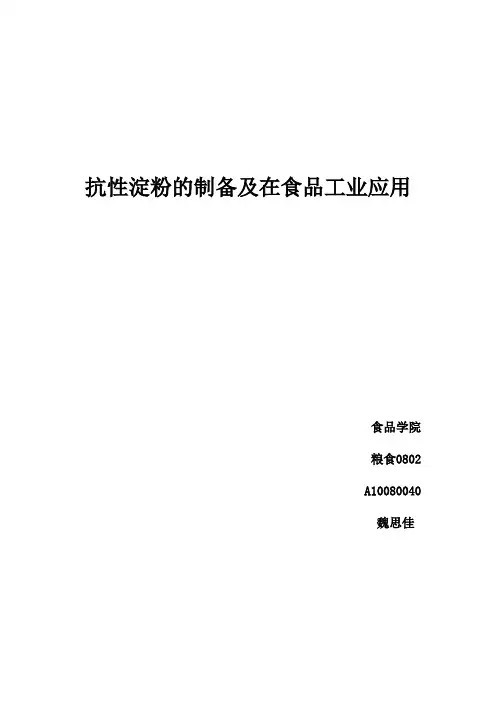
抗性淀粉的制备及在食品工业应用食品学院粮食0802A10080040魏思佳抗性淀粉的制备研究及其在食品工业中的应用论文关键词:抗性淀粉、分类、制备、生理功能、应用、食品工业论文摘要:抗性淀粉是近年发展起来的新概念,其功能特性引发了人们的研究兴趣,并成为国际上新兴的食品研究领域。
论述了抗性淀粉的分类、制备、理化性质、生理功能及其在食品工业中的应用。
Abstract: Resistant starch was a newly developed concept and had become the focus for study in the fields of food science and technology. The paper described the classification of resistant starch and its preparation, physical and chemical properties, as well as its possible physiological effects in human beings and the application in food industry.抗性淀粉(resistant starch)又称抗酶解淀粉及难消化淀粉,在小肠中不能被酶解,但在人的肠胃道结肠中可以与挥发性脂肪酸起发酵反应。
抗性淀粉存在于某些天然食品中,如马铃薯、香蕉、大米等都含有抗性淀粉,特别是高直链淀粉的玉米淀粉含抗性淀粉高达60%。
这种淀粉较其他淀粉难降解,在体内消化缓慢,吸收和进入血液都较缓慢。
其性质类似溶解性纤维,具有一定的瘦身效果,近年来开始受到爱美人士的青睐。
一、RS的制备近年来,国外对抗性淀粉的制备研究非常活跃,发展很快,并有许多制备抗性淀粉的专利。
而我国对抗性淀粉的制备研究正处于起步阶段。
目前,对于RS 形成机理比较一致的认识是:直链淀粉双螺旋叠加(即直链淀粉重结晶)形成抗性淀粉。
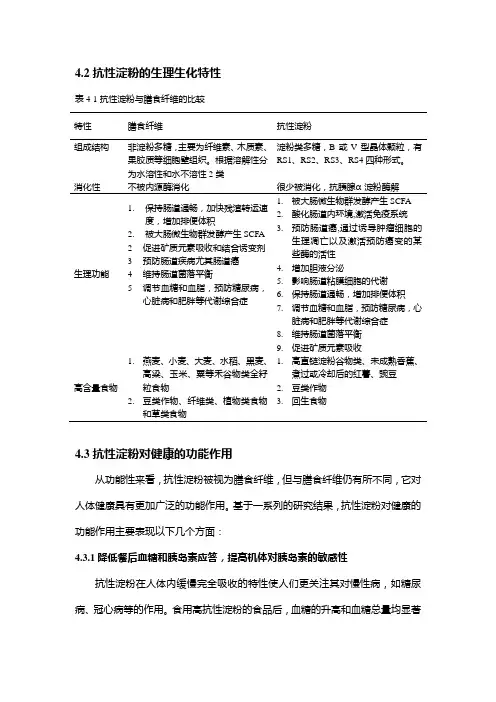
4.2抗性淀粉的生理生化特性表4-1抗性淀粉与膳食纤维的比较特性膳食纤维抗性淀粉组成结构非淀粉多糖,主要为纤维素、木质素、果胶质等细胞壁组织。
根据溶解性分为水溶性和水不溶性2类淀粉类多糖,B或V型晶体颗粒,有RS1、RS2、RS3、RS4四种形式。
消化性不被内源酶消化很少被消化,抗胰腺α-淀粉酶解生理功能1.保持肠道通畅,加快残渣转运速度,增加排便体积2.被大肠微生物群发酵产生SCFA2促进矿质元素吸收和结合诱变剂3预防肠道疾病尤其肠道癌4维持肠道菌落平衡5调节血糖和血脂,预防糖尿病,心脏病和肥胖等代谢综合症1.被大肠微生物群发酵产生SCFA2.酸化肠道内环境,激活免疫系统3.预防肠道癌,通过诱导肿瘤细胞的生理凋亡以及激活预防癌变的某些酶的活性4.增加胆液分泌5.影响肠道粘膜细胞的代谢6.保持肠道通畅,增加排便体积7.调节血糖和血脂,预防糖尿病,心脏病和肥胖等代谢综合症8.维持肠道菌落平衡9.促进矿质元素吸收高含量食物1.燕麦、小麦、大麦、水稻、黑麦、高梁、玉米、粟等禾谷物类全籽粒食物2.豆类作物、纤维类、植物类食物和草类食物1.高直链淀粉谷物类、未成熟香蕉、煮过或冷却后的红薯、豌豆2.豆类作物3.回生食物4.3抗性淀粉对健康的功能作用从功能性来看,抗性淀粉被视为膳食纤维,但与膳食纤维仍有所不同,它对人体健康具有更加广泛的功能作用。
基于一系列的研究结果,抗性淀粉对健康的功能作用主要表现以下几个方面:4.3.1降低餐后血糖和胰岛素应答,提高机体对胰岛素的敏感性抗性淀粉在人体内缓慢完全吸收的特性使人们更关注其对慢性病,如糖尿病、冠心病等的作用。
食用高抗性淀粉的食品后,血糖的升高和血糖总量均显著低于食用其它碳水化合物,这对改善II型糖尿病的代谢控制具有良好的作用。
国内外许多学者开展了抗性淀粉对血糖值和胰岛素水平的影响方面大量研究,一致认为抗性淀粉可延缓饭后血糖浓度的升高和降低胰岛素的分泌,同时可改善脂质的构成,从而有助于体重的控制和糖尿病的预防。
抗性淀粉的测量
C.实验试剂
(a)马来酸钠缓冲液:0.1M,pH6.0.取23.2g的马来酸溶解在1600ml的蒸馏水中,
用4M(160g/L)的NaOH调节pH值到6.0 ,加入0.6gCaCl2.2H2O和0.4g的叠
氮化钠,然后定容到2L。4℃保存1年。
(b)马来酸钠缓冲液:1.2M,pH3.8,69.6ml的冰醋酸溶解在800ml的蒸馏水中,用
4M的NaOH调节pH值到3.8.用蒸馏水定容到1L。室温下保存1年。
(c)马来酸钠缓冲液:100mM,pH4.5.5.8ml的冰醋酸溶解在900ml的蒸馏水中,用
4M的NaOH调节pH值 到4.5,最后用蒸馏水定容到1L,4℃下保存1年。
(d)氢氧化钾溶液:2M,取112.2KOH溶解在900ml的去离子水中,定容到1L
(e)IMS溶液:50%V/V。取500ml的乙醇(95%或99%)或工业甲基化酒精(IMS,
变性乙醇;95%乙醇加5%的甲醇),用水定容到1L,密封保存1年。
(f)AMG储备液:12ml,3300U/ml溶解在50%的甘油中,呈粘性。在4℃下保存5
年。(注:1U:在40℃,pH4.5的条件下,AMG分解可溶性淀粉产生1μmol
的葡萄糖所需要的酶量)。
(g)淀粉葡萄糖苷酶稀释液:300U/ml,将2ml的AMG储备液用0.1M,PH马来酸
缓冲液C(a)稀释到22ml,等分为5ml冷冻保存在聚丙烯管中,使用时可以反复
冻融,-20℃下保存5年。
(h)胰a-淀粉酶(10mg/ml)+AMG(3U/ml):1g的胰a-淀粉酶加100ml马来酸缓
冲液C(a),搅拌5min,加1.0mlAMG(300U/ml),搅拌离心,>1,500g,10min。
小心倒出上清液。现配现用。
(i)葡萄糖氧化酶-过氧化物酶-氨基安替比林溶液(GOPOD):制备GOPOD通过
稀释50ml的缓冲液到1.0L,用部分稀释缓冲液溶解冻干的GOPOD混合液,将
小瓶内的酶液转移到1.0L的容量瓶中,用稀释缓冲液定容到1.0L.
葡萄糖氧化酶 >12000U/L;
过氧化物酶 >650U/L;
4-氨基安替比林溶液 0.04mM
4℃保存2~3月,-20℃保存>2年
缓冲液的制备:
溶解136gkH2PO4,42gNaOH,30g的4-羟基苯甲酸,溶解在900ml水中,用
1MHCL和2MNaOH调节pH7.4,稀释到1L,添加0.4g叠氮化钠混合至溶解。4℃
保存3年。
3ml的GOPOD混合液,0.1ml葡萄糖标准液(1mg/ml,0.2%苯甲酸为溶剂),
0.1ml.0.1M的马来酸钠缓冲液[CI],20min显色完全。>1h显色依旧稳定。
试剂(f),(h)和(i)在RS试剂盒中。
D 样品的制备
将约50g的样品(谷物,低压冻干的植物,食品)研磨,过孔径1.0mm的
筛。将样品装入广口瓶中,混匀,工业淀粉粉末的精细度比较好,无需研磨。
新鲜食品的粉碎(如:灌装蚕豆,香蕉,土豆)通过手切或绞肉机粉碎到
能通过4.5mm的筛子,水分含量的测定方法AOAC925.10(15),新鲜的样品先经
过冻干,然后通过AOAC925.10方法烘干。
E.抗性淀粉的测量
(a)非抗性淀粉的溶解和水解
i:准确的称取100±5mg的样品至具塞试管中(16×125mm),轻碰管壁,确保
样品降到底部。
ii 每管中加4.0ml胰a-淀粉酶(10mg/ml)和AMG(3U/ml)[C(h)]。
iii 拧紧管帽,用涡旋仪混匀,水平放置在水浴摇床上,震荡。
iv 37℃,连续摇晃16h(200次/min)。
v 将试管从水浴摇床上取出,擦干试管表面水分,打开管帽,加入4ml 99%的乙
醇或99%的IMS,蜗旋仪上混匀。
Vi 将各管在1,500g(约:3,000rpm)离心10min(不加盖)
Vii 小心倒出上清液,用2ml50%的乙醇或IMS[C(e)]重悬,在蜗旋仪上混匀,再
添加6ml50%IMS,混匀,1,500g离心10min。
ix 弃去上清液,重复vii步骤一次。
x 小心的去掉上清液,倒置管上的吸水纸,吸取多余的液体。
(b)抗性淀粉的测量
i向每个管中添加一个磁力搅拌子(5×15mm)和2ml,2MKOH[c(d)]并重悬沉淀
(溶解抗性淀粉),在冰水浴中搅拌20min.
ii 添加8ml,1.2M的马来酸缓冲液(pH3.8)[c(b)]到每一个管中,在磁力搅拌器
上搅拌,立即添加0.1ml的AMG(3300U/ml)[c(f)]混匀,将管子放置在50℃的
水浴锅上水浴。
iii 在蜗旋仪中间歇搅拌30min。
iv 样品中抗性淀粉的含量>10%
将管中的物质转移到100ml的容量瓶中,使用清水清洗管子,当用洗瓶清洗
时,使用外部磁铁保持磁力搅拌子停留在管中,用清水定容到100ml混合均
匀,1,500g离心10min.
v样品中抗性淀粉的含量<10%
将管子直接离心,1,500g离心10min(不稀释),对上面的样品,管中的最终
体积约为10.3ml(如果分析的是湿样品,体积会有很大的不同,补充的量应该
计算在内)
vi 等量的转移0.1ml(两个平行),稀释液或未稀释液的上清液转移到玻璃管中
(16×100mm),加 3.0ml的GOPOD溶液处理并在50℃下保温20min.
vii 在510nm测定吸光值,溶液为空白。
F 非抗性淀粉(可消化)的测量
i 将[E(a)vii]步的上清液用50%乙醇清洗[E(a)ix和x],用水将体积定容到100ml。
ii 取0.1ml的溶液(2个平行),加3ml的GOPOD[C(i)],50℃保温20min。
iii 在510nm处比色。
iv 计算非抗性淀粉的总量。
G 计算
计算抗性淀粉,非抗性(可溶)淀粉,总淀粉含量(%,干重)
抗性淀粉(g/100g样品)(RS%>10%):
= DE x F x 100/0.1 x 1/1000 x 100/W x 162/180
= DE x F/W x 90.
抗性淀粉(g/100g样品)(RS%<10%)
= DE x F x 10.3/0.1 x 1/1000 x 100/W x 162/180
= DE x F/W x 9.27
非抗性(可溶)淀粉(g/100g样品)
= DE x F x 100/0.1 x 1/1000 x 100/W x 162/180
= DE x F/W x 90.
总淀粉=抗性淀粉+非抗性淀粉
注:DE=OD值
F=吸光值转换为μg数(100μg 的葡萄糖与GOPOD反应的吸光值且F=100μ
葡萄糖/100μg葡萄糖与GOPOD反应的吸光值)。
100/0.1 =体积校正(从100ml中取0.1ml).
1/1000=μg转换为mg
W= 样品分析的干重
=湿重×(100-水分含量)/100
100/W=样品中抗性淀粉的转换因子
162/180=葡萄糖转换为淀粉的转换因子。
10.3/0.1 =体积校正(10.3ml中取0.1ml),样品中包含0-10%的RS,溶液没有被
稀释终浓度为10.3ml。